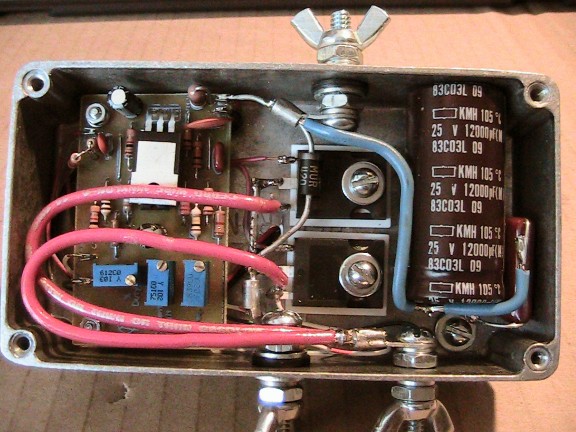|
Q) So what is
it?
A) I'm getting that question A LOT lately, despite
my many videos describing it, the main FAQ page and
the construction detail page here at this web site.
So, from the top, again:
It is a Pulse Width
Modulator or PWM. In the simplest terms, a PWM is just
an electronic switch that turns on and off at a very
fast rate of speed varying the percentage of time on
vs off. To the load it appears smooth because it's so
fast, just like our vision can barely detect the flicker
of a fluorescent bulb even though it goes completely
off and back on again 120 times a second. Typical PWMs
transition anywhere from sever hundred to tens of thousands
of times per second. The duty cycle of a PWM is the
percentage of on-time vs. off-time.
What makes mine different than your typical
lamp dimmer, DC motor speed controller or switching
power supply is that mine is more than just a variable
controller. It has current sensing capability. I have
created this PWM to provide very tight average current
regulation and/or limiting to a given load regardless
of the equivalent resistance value of the load. Using
the duty cycle control, it can just as easily be used
as a low voltage, very high current DC motor speed controller
or lamp dimmer if you want. But it was really designed
for HHO. The output is not filtered DC. It is still
a pulse train sent to the load.
Q) Will my HHO
cell be more efficient with your PWM? Will I get more
production?
A) The efficiency of an HHO cell is dependent
on the design and construction of the cell itself. A
PWM cannot increase the efficiency of a poorly designed
or poorly made cell. End of story.
Q) So why do
I need a PWM for HHO?
A) To prevent thermal runaway. HHO electrolyzers
naturally draw more current as they warm up. Equivalent
resistance drops. All brute force electrolyzers will
warm up, even the most efficient ones. At the end of
a day current can be easily three times as much as what
you started with at the beginning of the day. Without
a PWM the problem becomes finding the correct electrolyte
concentration for an entire day of operation. If you
start out weak then production is very slow at the beginning
of the day and you lose the benefits until much later
in the day. If you start out strong enough to see benefits
right away, by the end of the day you're blowing fuses
or greatly stressing your alternator.
With my current limited
PWM you set your electrolyte for the target operating
current at the beginning of the day from straight DC.
To start, the output duty cycle of the PWM should be
nearly 100%. Half way through the day, as the cell is
getting warm, it may want to draw as much as twice as
much current if it was being powered from the same straight
DC. The PWM, sensing that twice as much current is trying
to flow every time it switches on, rolls back the duty
cycle to 50%, thus maintaining the same average current
output. At the end of day when the cell wants to draw
three times as much current, the PWM will operate at
33% duty cycle.
Q) Can I tune
your PWM without the use of an oscilloscope?
A) Yes. An adjustment procedure is included in the
instruction manual that does not require the use of
an oscilloscope. I use it only because it makes the
tuning much faster.
Q) Do you endorse
less expensive PWM being sold based on your design?
A) My plans are open source. Anyone can make
them freely and sell them if they wish. But, even though
they are based on my designs, I will not provide any
product support for anything that I did not make. I
have seen some of the copies first hand and I can tell
you, the people making them are going to have unhappy
customers. Some look almost identical to mine from the
outside but there are details in the manufacture that
they overlook or deliberately omit simply because they
are not an electronics engineer as I am and do not understand
their importance. Mine cost more because I am the
one who put the work into designing it and I take
the time to pay attention to the small details that
make all the difference. Mine work as advertised and
they are proven to last.
Q) What if parts
fail? Can I get replacements? They are expensive or
hard to get where I live.
A) Most parts can be mail ordered through Mouser.
However, there are very few parts that fail in my units.
After the first 20 or so units I produced, I learned
what failed most often and made a couple of small and
unpublished design changes. I don't see these
failures anymore. While the original design works fine,
copies being made by others do not have these reliability
design changes in them. I need to do this from time
to time in order to maintain a competitive edge over
the copycats and profiteers who try to undercut my prices.
They are simply not equipped to adapt to changes the
way I can because they do not possess the skills needed.
I can send you some spare parts with your order upon
special request for a small fee.
Q) What is the
cost for you to repair if I do manage to blow one up
anyway?
A) I charge a $50 flat labor fee to diagnose,
repair and test, plus parts, plus the return S&H.
Click
here for the instruction manual in pdf format.
Click here for a detailed circuit
description.
|
![]()



